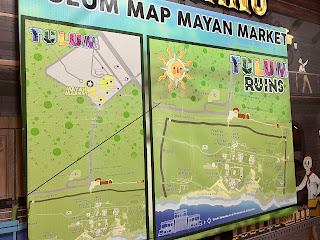Exploring the Tulum Mayan Ruins: Coastal History and Sunny Cliffside Views


🚌 Getting There: Cruise Convenience Meets Local Charm
We boarded the early ferry from Cozumel to Playa del Carmen, coordinated through our cruise line. From there, a smooth and comfortable bus ride whisked us to Tulum. Our local guide was full of fascinating insights about the Mayan people, their traditions, and how life might have been before Spanish colonization.
We learned that Tulum was once a walled trading port city known as Zama (meaning “City of Dawn”), named for its beautiful sunrises. It was one of the last cities inhabited and built by the Maya, and its cliffside location overlooking the Caribbean Sea made it both strategic and stunning. You could imagine ships docking below and merchants walking through the stone archways into the bustling city.
According to Mayans and Tikal, Tulum served as a major trading hub around the 13th–15th centuries and remained active up until the late 1500s. Its iconic temple, El Castillo, was likely used as a lighthouse or watchtower for approaching canoes — a beacon of civilization in its time.
(Disclaimer: Some of the links on here are affiliate links and I may earn if you click or buy on them, AT NO EXTRA cost to you. Hope you find the information here useful! Thanks.)
🚶♀️ Exploring the Site
Once we arrived, we passed through a marketplace filled with food stalls and souvenir shops, then followed a path that brought us to the entrance of the archaeological site. For those traveling independently, entry to the ruins is very affordable — definitely an option to consider if you're not worried about time constraints.
Walking through the ruins was awe-inspiring. The ancient stone buildings, set against the backdrop of turquoise waters and dramatic cliffs, made it one of the most scenic historical sites we've visited. The site is well-preserved, though you're not allowed to climb or touch the structures — understandably so.
The layout is compact but rich in history and views. We strolled past structures such as the Temple of the Frescoes and the Temple of the Descending God, all while lizards scurried past and tropical birds chirped in the trees.
And yes — there’s a path that leads down to the beach! Although we didn’t get time to swim, just standing on the cliff and gazing at the clear waters below made us wish we had brought our swimsuits. It’s easy to see why this location was sacred to the Mayans and why it continues to capture hearts today.
💭 Ruins Are Ruins... or Are They?
As we admired the rocky remains of what was once a vibrant city, we couldn’t help but laugh and say, “ruins are ruins.” Like the Roman ruins in Europe, it’s easy to reduce ancient history to piles of stones. But in places like Tulum, with the sea breeze and the knowledge of what once was, those stones speak volumes.
It also made us wonder — should we make it out to Chichen Itza next time? It’s arguably the most famous Mayan ruin, and while it’s much more crowded and touristy, it might be worth the trip. We’ll have to see what my brother says about his experience before deciding. (Stay tuned!)
☀️ Final Thoughts
Tulum is the kind of place where you want to stay longer. If we return to this part of Mexico outside of a cruise, we’d love to take our time, bring a picnic, walk the beach, and soak it all in.
Pros:
-
Stunning cliffside views
-
Easy to explore with or without a guide
-
Rich cultural history and natural beauty
-
Close to Playa del Carmen (easy access for independent travelers)
Cons:
-
Can get hot — bring water and sun protection
-
Crowded depending on the time of year
-
No touching or climbing the ruins
All in all, highly recommend visiting the Tulum Mayan Ruins — especially if you're looking for something more enriching than just a beach day. For The Trekking Pawns, it was a memorable cultural moment on an otherwise ocean-soaked cruise vacation.











Comments
Post a Comment